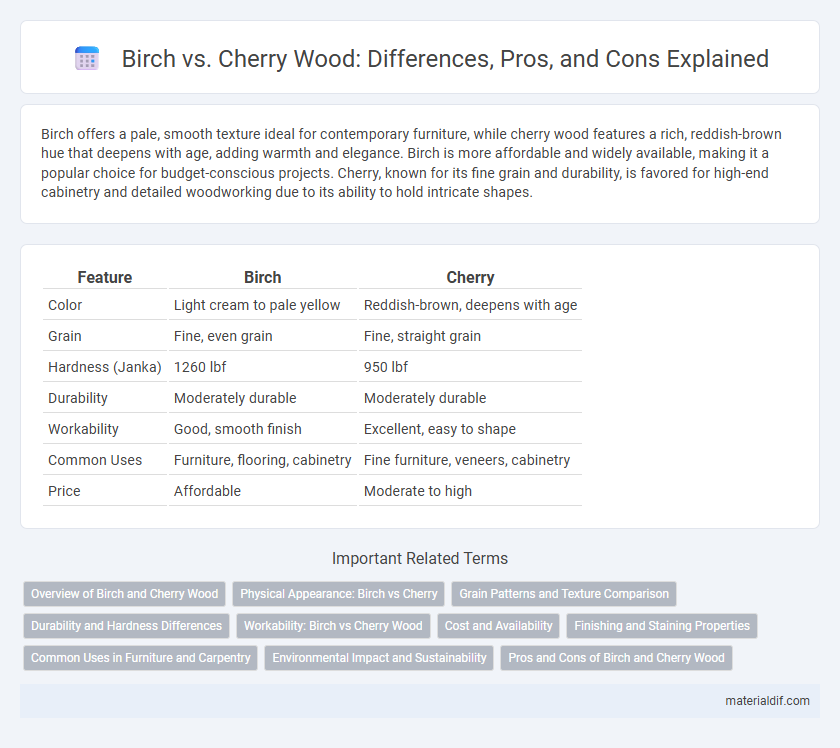Birch offers a pale, smooth texture ideal for contemporary furniture, while cherry wood features a rich, reddish-brown hue that deepens with age, adding warmth and elegance. Birch is more affordable and widely available, making it a popular choice for budget-conscious projects. Cherry, known for its fine grain and durability, is favored for high-end cabinetry and detailed woodworking due to its ability to hold intricate shapes.
Table of Comparison
| Feature | Birch | Cherry |
|---|---|---|
| Color | Light cream to pale yellow | Reddish-brown, deepens with age |
| Grain | Fine, even grain | Fine, straight grain |
| Hardness (Janka) | 1260 lbf | 950 lbf |
| Durability | Moderately durable | Moderately durable |
| Workability | Good, smooth finish | Excellent, easy to shape |
| Common Uses | Furniture, flooring, cabinetry | Fine furniture, veneers, cabinetry |
| Price | Affordable | Moderate to high |
Overview of Birch and Cherry Wood
Birch wood is known for its pale cream color with a subtle grain pattern, offering a smooth texture ideal for furniture and cabinetry. Cherry wood features a rich reddish-brown hue that deepens with age, prized for its fine, straight grain and smooth finish suitable for high-end woodworking projects. Both hardwoods provide durability, but birch is generally more affordable and widely available compared to cherry, which is favored for its elegant appearance and natural luster.
Physical Appearance: Birch vs Cherry
Birch wood features a pale cream to light brown color with a smooth, fine grain that often displays subtle waves or curls, creating a uniform and light aesthetic. Cherry wood exhibits a rich, warm reddish-brown hue that deepens with age, showcasing a fine, straight grain with occasional curls or burrs that add character and depth. The natural warmth of cherry contrasts with the lighter, more neutral tones of birch, making each ideal for different design preferences based on color intensity and grain pattern.
Grain Patterns and Texture Comparison
Birch wood features a fine, even grain pattern with subtle curves and a smooth texture, offering a consistent and uniform appearance ideal for modern furniture and cabinetry. Cherry wood displays a more pronounced, flowing grain with occasional swirls and a satiny texture that develops a rich patina over time, making it highly valued for its aesthetic warmth and depth. Both woods provide durable surfaces, but Birch's tighter grain contrasts with Cherry's distinctive, elegant figure, influencing their use in different design styles.
Durability and Hardness Differences
Birch wood exhibits moderate durability with a Janka hardness rating around 1260, making it suitable for furniture and flooring that experience regular use but not extreme wear. Cherry wood, slightly softer with a Janka hardness near 950, offers excellent workability and a fine grain but is less resistant to dents and scratches compared to birch. Choosing between birch and cherry depends on the balance between desired hardness for durability and the aesthetic warmth of cherry's rich color.
Workability: Birch vs Cherry Wood
Birch wood offers excellent workability with its fine, even grain that allows for smooth cutting, sanding, and finishing, making it ideal for detailed woodworking projects. Cherry wood, while slightly harder, is still highly workable and polishes to a rich, smooth finish, often preferred for fine furniture and cabinetry. Both woods respond well to staining and shaping, but birch's uniform texture provides greater ease in intricate carving compared to cherry's natural luster and color variations.
Cost and Availability
Birch wood is generally more affordable and widely available in North America and Europe due to its faster growth rate and abundance, making it a cost-effective choice for furniture and cabinetry. Cherry wood, known for its rich color and fine grain, commands a higher price because it grows slower and is less common, with availability often limited to specialized suppliers. Choosing between birch and cherry depends on budget constraints and project requirements, as birch offers economical versatility while cherry provides premium aesthetic appeal.
Finishing and Staining Properties
Birch wood exhibits a smooth surface that absorbs stains evenly, resulting in a consistent finish ideal for clear or medium-tone stains. Cherry wood, known for its natural reddish hue, deepens in color over time and responds well to darker stains, enhancing its rich grain patterns. Finishing cherry requires careful sanding to preserve its fine texture, while birch's harder surface may need a wood conditioner to prevent blotchiness during staining.
Common Uses in Furniture and Carpentry
Birch is frequently used in furniture making and carpentry for its strength, fine grain, and pale color, making it a popular choice for cabinets, dressers, and flooring. Cherry wood, valued for its rich reddish-brown hue and smooth texture, is commonly employed in high-end furniture, cabinetry, and decorative veneers. Both woods are favored for their durability and workability, with birch often chosen for functional woodwork and cherry prized for its aesthetic appeal.
Environmental Impact and Sustainability
Birch wood is abundant and grows relatively quickly, making it a more sustainable choice with a lower environmental impact compared to cherry wood, which takes longer to mature and is less common. Harvesting practices for birch typically result in reduced soil erosion and better forest regeneration. Cherry wood's slower growth rate contributes to increased carbon storage, but its limited availability and higher demand can lead to deforestation concerns.
Pros and Cons of Birch and Cherry Wood
Birch wood features a fine grain and pale color, offering durability and resistance to shock, making it ideal for furniture and cabinetry, but it can be prone to warping under high humidity. Cherry wood boasts a rich, warm reddish hue that darkens with age, prized for its smooth texture and excellent workability, yet it tends to be softer and more susceptible to dents compared to hardwoods like oak. Both woods provide stability and aesthetic appeal, with birch being more budget-friendly and cherry valued for its elegant finish and aging properties.
Birch vs Cherry Infographic

 materialdif.com
materialdif.com